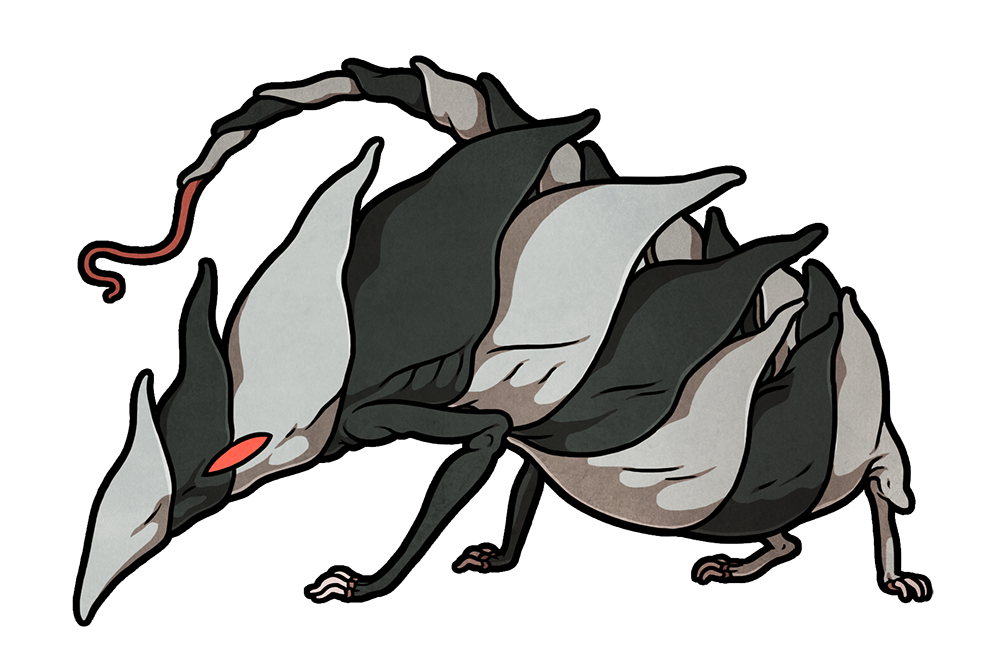

Zitirizandre
the Facades
prefix zitiri suffix zandre
rexxosi ziziriax
physical appearance
The zitirizandre /zɪtəɹəˈzændɹə/ is a stranger characterized by the alternating stripes that point-and-asner upwards into "fins", with its ungainly body culminating in a thin, slick tail tip. It is the hard and rubbery outer plasti-skin of these fins that gives the stranger its rigidity, rather than the flimsy and useless foam filling that breaks apart when handled. This inconsequencial stuffing can be removed from the zitirizandre's body without causing it harm – the tail tip, however, cannot be cut off without killing the stranger itself.
Its body never heals from injury, and its surface grows drab over time. When rubbed, its odor becomes pungent, recalling a mix of familiar smells too myriad to be fully specified.
Under normal circumstances, the zitirizandre is silent.
outside the space, a songbird's song.

environment and generation
The zitirizandre generates in locations in which plays or other narrative performances take place, such as theaters, community centers, or schools. Smaller buildings are more likely to host an infestation, with dark walls, sloped flooring, lockers, and a lack of windows all further multiplying the odds. (The longer the room, the better.) Within these spaces, the stranger starts off as a thin tube whose full shape expands and uncrumples into the mature zitirizandre in the span of a few shaky half-breaths.
behaviour and effects
The zitirizandre possesses an apprehensive but methodical personality. It acts like a human being imitating an animal's movements. If rarely seeming to mimic a specific creature, its traits instead recall a wide range of four-legged animals, from canines and horses, to crocodiles and lions.
The zitirizandre spends the majority (77.7%) of its time in a motionless state – shaking into animacy when approached by a sensitive, but otherwise ambivalent to its surroundings. (Breathing in and out, and waiting.) When not at rest, it displays a constant suspicion towards its surroundings, which it never seems to grow accustomed to. The zitirizandre "sniffs" at the edges of tables, runs its hands over carpet-seams, stares at buzzing lightbulbs, pounds lockers, and pulls on any ropes or chains. It also behaves as if either listening for or reacting to non-existed sounds or stimulus, though regardless of its reaction, the zitirizandre's "mood" does not grow any more agitated than its leery base state.
While the stranger does not seek out any specific objects or stimulus, it does, display one incidental pleasure. Should the zitirizandre find itself wrapped up in heavy curtains, its demeanor grows playful and passive for the duration of the event, with velvet curtains pacifying it above all else.
construction of barriers, and social interactions
The zitirizandre attempts to create barriers between itself and the nearest sensitive, regardless of how far away the sensitive is. It uses its surprising strength to gather large, flat planes of cardboard, plywood, or other similar materials, which it props up into walls tall enough to hide its body (fins and all). Highly dextrous (if showing no tendency towards tool use), the zitirizandre is able to tie strings in strong binding knots, push nails into even firm wood with its bare hands, and twist screws in place to create walls that, though seeming superficially (in short, made sloppy on purpose) slipshod and makeshift in their construction, are assembled with a high level of rigidity and skill.
When two zitirizandre occupy the same territory, they build their first barrier together, creating a structure that separates the territory into two halves. Once the wall is constructed, the pair display no other social tendencies, and remain on separate sides, where their behaviours otherwise play out as expected.
interactions with sensitives
No matter what, the zitirizandre always attempts to use its barriers to stay hidden from view. It moves away when approached, but otherwise, does not react strongly to interaction, and can be killed without a struggle.
When observed from over the top of the barrier, the zitirizandre's voice becomes audible to the sensitive. This voice eminates not from the stranger's body, but rather, seem to fill乚 the room itself. Each stranger possesses a distinct choir of ten to fifteen species (with dozens of apparent "singers" of each of these species).
ଳ
"Darwin"
1 Baiji dolphin
2 Bermuda hawk
3 Caribbean monk seal
4 Glaucous macaw
5 Javan lapwing
6 Madeiran wood pigeon
7 Peringuey's seedpod shieldback
8 Pyrenean ibex
9 Rabbs' fringe-limbed treefrog
10 Saudi gazelle
ବି
"Barnum"
1 Arboreal seedpod shieldback
2 Bermuda saw-whet owl
3 Bramble Cay melomys
4 Calbali bush-cricket
5 Christmas Island pipistrelle
6 Eastern cougar
7 Guam reed-warbler
8 Negros fruit dove
9 Pernambuco pygmy owl
10 Spix Macaw
11 Western black rhinoceros
Though the arrangement varies between individual zitirizandre, the stranger only imitates species driven into extinction within the decade prior to its generation.
ର
"Temple"
1 African penguin
2 Beluga whale
3 Bouvier's red colobus
4 Franklin's bumblebee
5 Golden-bellied capuchin
6 Greater bamboo lemur
7 Indian Cheetah
8 Ivory-billed woodpecker
9 Mahé boulder cricket
10 Okapi
11 Red wolf
12 Reticulated giraffe
13 Santorini cave-cricket
14 Sumatran elephant
15 Western lowland gorilla
aging and death
As the stranger ages, so too does its energy decline. Its motions grow tired, and its vigilence wanes, eventually settling into a state that can be interpreted as fatigued acceptance. The animal cries in its chorus lose spirit२ and die off one-by-one, as well – commanding roars turn to drowsy grumbles, and the silence between chirps and trills grows longer and longer.
Once the last voice within its choir goes silent, the zitirizandre freezes suddenly in place (defying even balance and gravity to do so), before its corpse flakes apart into long, papery sheets. These "leaves" shrivel into nothing within the hour, leaving the left-behind walls as the only marker of the zitirizandre's presence.



